County of Nassau
(Princely) County of Nassau Principalities of Nassau | |||||||||
|---|---|---|---|---|---|---|---|---|---|
| 1125–1806 | |||||||||
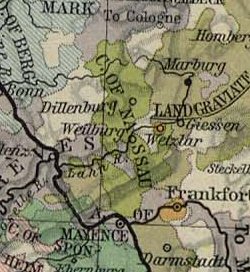 County of Nassau in 1547 | |||||||||
| Status | County | ||||||||
| Capital | Nassau | ||||||||
| Common languages | German (Rhine Franconian dialects, Moselle Franconian dialects) | ||||||||
| Government | County | ||||||||
| Historical era | Middle Ages | ||||||||
• City founded | 915 | ||||||||
• Rupert I claims title of count | 1125 | ||||||||
• Comital title acknowledged | 1159 | ||||||||
• Partitioned multiple times | 1255–1806 | ||||||||
• Remaining parts unified to form duchy | 1806 | ||||||||
| |||||||||
| Today part of | Germany | ||||||||
The County of Nassau was a German state within the Holy Roman Empire and later part of the German Confederation. Its ruling dynasty, the male line of which is now extinct, was the House of Nassau.
Origins
Nassau, originally a county, developed on the lower Lahn river in what is known today as Rhineland-Palatinate. The town of Nassau was founded in 915.[1] Dudo of Laurenburg held Nassau as a fiefdom as granted by the Bishopric of Worms. His son, Rupert, built the Nassau Castle there around 1125, declaring himself "Count of Nassau". This title was not officially acknowledged by the Bishop of Worms until 1159 under the rule of Rupert's son, Walram. By 1159, the County of Nassau effectively claimed rights of taxation, toll collection, and justice, at which point it can be considered to become a state.[1]
The Nassauers held the territory between the Taunus and the Westerwald at the lower and middle Lahn. By 1128, they acquired the bailiwick of the Bishopric of Worms, which had numerous rights in the area, and thus created a link between their heritage at the lower Lahn and their possessions near Siegen. In the middle of the 12th century, this relationship was strengthened by the acquisition of parts of the Hesse-Thüringen feudal kingdom, namely the Herborner Mark, the Kalenberger Zent and the Court of Heimau (Löhnberg). Closely linked to this was the "Lordship of Westerwald", also in Nassau's possession at the time. At the end of the 12th century, the House acquired the Reichshof Wiesbaden, an important base in the southwest.
In 1255, after the Counts of Nassau acquired the estates of Weilburg, the sons of Count Henry II divided Nassau for the first time. Walram II received the county of Nassau-Weilburg. From 1328 on, his younger brother, Otto I, held the estates north of the Lahn river, namely the County of Nassau-Siegen and Nassau-Dillenburg. The boundary line was essentially the Lahn, with Otto receiving the northern part of the county with the cities of Siegen, Dillenburg, Herborn and Haiger and Walram retaining the section south of the river, including the cities of Weilburg and Idstein.
County of Nassau-Weilburg
Walram's son Adolf became King of Germany in 1292. His son Count Gerlach abdicated in 1344 and the County was divided under his sons in 1355
- County of Nassau-Weilburg, again divided from 1442 to 1574
- County of Nassau-Saarbrücken (Elder)
- County of Nassau-Weilburg
- County of Nassau-Wiesbaden, again divided from 1480 to 1509
- County of Nassau-Idstein
- County of Nassau-Wiesbaden
fell back to Nassau-Weilburg in 1605
- County of Nassau-Sonnenberg, partitioned among Nassau-Wiesbaden and Nassau-Weilburg in 1405
In 1605, all parts of Nassau-Weilburg were again unified under Count Louis II; however, after his death in 1627, his sons divided the county again
- County of Nassau-Idstein, fell to Nassau-Ottweiler in 1721
- County of Nassau-Saarbrücken (Younger), divided again in 1640
- County of Nassau-Saarbrücken, fell to Nassau-Ottweiler in 1723
- County of Nassau-Ottweiler, fell to Nassau-Usingen in 1728
- County of Nassau-Usingen, Principality in 1688
- County of Nassau-Weilburg (Younger)
After Nassau-Usingen had inherited Nassau-Ottweiler with former Nassau-Idstein and Nassau-Saarbrücken, it was reunified with Nassau-Weilburg and raised to the Duchy of Nassau in 1806.
County of Nassau-Dillenburg
After the death of Count Otto I, his county was divided between his sons in 1303:
- County of Nassau-Dillenburg, fell to Nassau-Siegen in 1328
- County of Nassau-Hadamar (Elder), fell to Nassau-Dillenburg in 1394
- County of Nassau-Siegen, called Nassau-Dillenburg from 1328 on, again got divided from 1341 to 1561:
- County of Nassau-Beilstein (Elder)
- County of Nassau-Dillenburg (Elder)–1606)
In 1504, Henry III of Nassau-Dillenburg inherited the County's estates at Breda in the Duchy of Brabant, while his younger brother William became Count of Nassau-Dillenburg in 1516. After the son of Henry III, René of Châlon died in 1544, Count William's eldest son William the Silent became Prince of Orange and Lord of Breda, Stadtholder in the Low Countries from 1559 on. His younger brother, John VI, again reunited all Nassau-Dillenburg possessions in 1561, though the County was again divided after his death in 1606.
- County of Nassau-Hadamar (Younger), Principality in 1650, fell to Nassau-Diez in 1743
- County of Nassau-Siegen, (1607–23), again got divided from 1623 to 1734:
- County of Nassau-Siegen (Protestant), Principality in 1664, became extinct in 1734
- County of Nassau-Siegen (Catholic), Principality, fell to Nassau-Diez in 1743
- County of Nassau-Dillenburg, fell to Nassau-Beilstein in 1620
- County of Nassau-Beilstein (Younger), called Nassau-Dillenburg (Younger) from 1620 on, Principality in 1652, fell to Nassau-Dietz in 1739
- County of Nassau-Dietz, fell to Joachim Murat's Grand Duchy of Berg after the dissolution of the Holy Roman Empire in 1806
The Counts of Nassau-Dietz, descendants of William Frederick were stadtholders of Friesland, Groningen and Drenthe and Princes of Orange from 1702 on. When they lost their Dutch possessions during the Napoleonic Wars, they were compensated with the Principality of Nassau-Orange-Fulda. Though they lost their German possessions in 1806, the House of Orange-Nassau, through female succession, was the reigning house of the Grand Duchy of Luxembourg until 1890 and is still the royal house of the Netherlands.
Rulers
House of Nassau
Partitions of Nassau under House of Nassau rule
| County of Laurenburg/ Nassau (1093-1255) | |||||||||||||||||||||||||||||
 County of Northern Nassau (Ottonian Line) (1255-1303) |
 County of Southern Nassau (Walramian Line) (1255-1355) | ||||||||||||||||||||||||||||
| County of Nassau-Siegen (1st creation) (1303-1328) |
County of Nassau-Hadamar (1st creation) (1303-1394) | ||||||||||||||||||||||||||||
| County of Nassau-Beilstein (1343-1561) |
|||||||||||||||||||||||||||||
| County of Nassau-Sonnenberg (1355-1404) |
|||||||||||||||||||||||||||||
| County of Nassau-Dillenburg (1303-1654) (Siegen line from 1328) Raised to: Principality of Nassau-Dillenburg (1654-1739) |
County of Nassau-Weilburg (1355-1806) | ||||||||||||||||||||||||||||
| Barony of Nassau-Breda (1403-1544) Raised to, and renamed as: Principality of Orange-Nassau (1st creation, Dillenburg line) (1544-1702) |
County of Nassau-Idstein (1st creation) (1355-1605) (divided 1370-86; 1480-1509; 1554-56; 1564-66) | ||||||||||||||||||||||||||||
| County of Nassau-Saarbrücken (1st creation) (1429-1574) | |||||||||||||||||||||||||||||
| County of Nassau-Siegen (2nd creation) (1606-1652/64) (In 1623 divided in Catholic and Protestant ruling lines) Both lines raised to: Catholic Principality of Nassau-Siegen (1652-1743) and Protestant Principality of Nassau-Siegen (1664-1734) |
|||||||||||||||||||||||||||||
| County of Nassau-Hadamar (2nd creation) (1620-1650) Raised to: Principality of Nassau-Hadamar (1650-1711) | |||||||||||||||||||||||||||||
| County of Nassau-Idstein (2nd creation) (1627-1688) Raised to: Principality of Nassau-Idstein (1688-1721) | |||||||||||||||||||||||||||||
| County of Nassau-Ottweiler (1659-1721) |
|||||||||||||||||||||||||||||
| County of Nassau-Dietz (1606-1654) Raised to: Principality of Nassau-Dietz (1654-1702) Renamed as: Principality of Orange-Nassau (2nd creation, Dietz line) (1702-1806) |
County of Nassau-Saarbrücken (2nd creation) (1627-1728) | ||||||||||||||||||||||||||||
| County of Nassau-Usingen (1659-1688) Raised to: Principality of Nassau-Usingen (1688-1806) | |||||||||||||||||||||||||||||
| Principality of Nassau-Saarbrücken (1741-1797) | |||||||||||||||||||||||||||||
| Annexed by France | |||||||||||||||||||||||||||||
| Orange-Nassau (2nd creation, Dietz line) (1813-1815) |
Duchy of Nassau (1806-1866) | ||||||||||||||||||||||||||||
| Annexed by Prussia | |||||||||||||||||||||||||||||
Table of rulers
| Ruler | Born | Reign | Death | Ruling part | Consort | Notes | ||
|---|---|---|---|---|---|---|---|---|
| Dudo | ? | 1093-1117 | c.1117 | County of Laurenburg/Nassau | Irmgard/Demudis of Arnstein three children |
Founder of the family and the county. | ||
| Rupert I | c.1090 | 1117-1154 | c.1154 | County of Laurenburg/Nassau | Beatrix of Limburg before 1135 four children |
Sons of Dudo, ruled jointly. Arnold abdicated from the co-regency. | ||
| Arnold I | c.1090 | 1117-1148 | After 1154 | County of Laurenburg/Nassau | Unmarried | |||
| Arnold II | c.1137 | 1154-1159 | c.1159 | County of Laurenburg/Nassau | Unknown at least one child |
Sons of Rupert I, ruled jointly. | ||
| Rupert II | c.1137 | 1154-1159 | c.1159 | County of Laurenburg/Nassau | Beatrix at least two children | |||
| Regency of Beatrix of Limburg (1159-1160) | Cousins, ruled together. Rupert III, Arnold II's son, co- ruled with Henry I, Rupert II's son. In 1167, Henry I died in Rome during the August 1167 epidemic (after the Battle of Monte Porzio). His death made his brother Waleran replace him in the co-regency. In 1191, Rupert III's death made his son Herman the new co-regent, but he abdicated the next year. In 1193, Waleran I (then already sole ruler) would become the first legalized Count of Nassau. | |||||||
| Rupert III the Bellicose | before 1159 | 1159-1191 | 23/28 December 1191 | County of Laurenburg/Nassau | Elisabeth of Leiningen 1169 two children | |||
| Henry I | before 1159 | 1159-1167 | August 1167 | County of Laurenburg/Nassau | Unmarried | |||
| Waleran I | c.1146 | 1167-1198 | 1 February 1198 | County of Laurenburg/Nassau | Kunigunde of Ziegenhain before 1135 four children | |||
| Herman | ? | 1191-1192 | After 1206 | County of Laurenburg/Nassau | Unmarried | |||
| Henry II the Rich | c.1180 | 1198-1251 | 26 April 1251 | County of Nassau | Matilda of Guelders before 1221 eleven children |
Sons of Waleran I, ruled together. From 1230 to 1240, Rupert was a Knight of the Teutonic Order. | ||
| Rupert IV | c.1180 | 1198-1230 | c.1239 | County of Nassau | Gertrude of Kleeberg c. 11 December 1215 no children | |||
| Henry II's sons, Waleran II and Otto I, who were ruling together, split the Nassau possessions on 17 December 1255, by a treaty called [[:de:Prima divisio, which determined the Lahn river as border of the two halves: to the south, called Southern Nassau, was ruled by Waleran and his descendants, who became known as the Walramian Line, which became important in the County of Nassau and Luxembourg; to the north, called Northern Nassau the county was ruled by Otto and his descendants, who became known as the Ottonian Line, which would inherit parts of Nassau, France and the Netherlands.
| ||||||||
| Otto I | c.1220 | 1251-1255 | between 3 May 1289 and 19 March 1290 | County of Nassau | Agnes of Leiningen five children |
Son of Henry II, received the land to the north of Lahn river: He was count of Nassau in Dillenburg, Hadamar, Siegen, Herborn and Beilstein. | ||
| 1255-1289/90 | Northern Nassau | |||||||
| Waleran II | c.1220 | 1251-1255 | 24 January 1276 | County of Nassau | Adelaide of Katzenelnbogen before 1250 seven children |
Son of Henry II, received the land to the south of Lahn river: He was count of Nassau in Wiesbaden, Idstein, and Weilburg. | ||
| 1255-1276 | Southern Nassau | |||||||
| Adolph I |  |
c.1255 | 1276-1298 | 2 July 1298 | County of Southern Nassau | Imagina of Isenburg-Limburg 1270 eight children |
In 1292 was crowned King of Germany. | |
| Emicho I | before 1289 | 1289/90-1303 | 7 June 1334 | County of Northern Nassau | Anna of Nuremberg before 1297 eight children |
Sons of Otto I, ruled together until 1303, when they divided the land: Henry received Nassau-Siegen
(Siegen, Ginsberg, Haiger, and the Westerwald), Emicho received Nassau-Hadamar and John received Nassau-Dillenburg. However, after the childless death of John, Nassau-Dillenburg (and the towns of Dillenburg, Herborn, and Beilstein) fell to Nassau-Siegen, which adopted the name Nassau-Dillenburg. Siegen and Dillenburg were united until 1606. | ||
| 1303-1334 | County of Hadamar | |||||||
| John I | c.1290 | 1289/90-1303 | 10 August 1328 | County of Northern Nassau | Unmarried | |||
| 1303-1328 | County of Dillenburg | |||||||
| Henry I | 
|
before 1288 | 1289/90-1303 | July/August 1343 | County of Northern Nassau | Adelaide of Sponheim-Heinsberg 1302 five children | ||
| 1303-1328 | County of Siegen | |||||||
| 1328-1343 | County of Dillenburg | |||||||
| Nassau-Dillenburg was annexed to Nassau-Siegen, which adopted the name Nassau-Dillenburg | ||||||||
| Rupert V | c.1280 | 1298-1304 | 2 November 1304 | County of Southern Nassau | Unmarried | Left no descendants. He was succeeded by his brother, Gerlach. | ||
| Gerlach I | 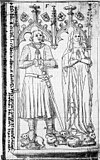 |
c.1285 | 1304-1355 | 7 January 1361 | County of Southern Nassau | Agnes of Hesse 1307 seven children Irmgard of Hohenlohe-Weikersheim before 4 January 1337 two children |
Brothers of Rupert V, ruled jointly for a brief period (1312-1316). In 1355 Gerlach abdicated to his sons, who divided the land. | |
| Waleran III | c.1294 | 1312-1316 | 22 December 1324 | County of Southern Nassau | Unmarried | |||
| John I | after 1302 | 1334-1365 | 20 January 1365 | County of Hadamar | Elisabeth of Waldeck 1331 ten children |
Sons of Emicho I, ruled jointly. | ||
| Emicho II | after 1302 | 1334-1359 | 1 March 1359 | County of Hadamar | Unmarried | |||
| Otto II |  |
c.1305 | 1343-1351 | 6 January 1351 | County of Dillenburg | Adelaide of Vianden 23 December 1331 four children |
Children of Henry I, divided the land: Otto kept Dillenburg, and Henry inherited Beilstein, partitioned from Dillenburg. | |
| Henry I | 11 June 1323 | 1343-1378 | 28 October 1378 | County of Beilstein | Imagina of Westerburg 1339 three children | |||
| Adelaide of Vianden |  |
c.1305 | 1351-1376 | 30 September 1376 | County of Dillenburg (at Mengerskirchen) |
Otto II, Count of Nassau-Dillenburg 23 December 1331 four children |
Widow of Otto II, inherited Mengerskirchen from her husband. After ther death, the town went to Nassau-Beilstein. | |
| John I | c.1340 | 1351-1416 | 4 September 1416 | County of Dillenburg | Margaretha of the Marck 30 November 1357 six children |
Inherited Vianden. | ||
| Crato | c.1340 | 1355-1356 | 1356 | County of Sonnenberg | Unmarried | Children of Gerlach I, divided the land:
| ||
| John I | c.1309 | 1355-1371 | 20 September 1371 | County of Weilburg | Gertrude of Merenberg 1333 one child Johanna of Saarbrücken 1353 seven children | |||
| Adolph I |  |
c.1307 | 1355-1370 | 17 January 1370 | County of Idstein | Margaret of Nuremberg 1322 fourteen children | ||
| Rupert (VI) the Warrior | c.1340 | 1356-1390 | 4 September 1390 | County of Sonnenberg | Anna of Nassau-Hadamar 1362 no children | |||
| Elisabeth of Waldeck | after 1302 | 1365-1381 | c.1381 | County of Hadamar (at Ems) |
John I, Count of Nassau-Hadamar 1331 ten children |
Widow of John I, ruled at Ems. | ||
| Henry I | after 1331 | 1365-1368 | 1368 | County of Hadamar | Unmarried | Left no descendants. He was succeeded by his brother. | ||
| Emicho III | after 1331 | 1368-1394 | 1394 | County of Hadamar | Brother of Henry, left no descendants. The land was annexed to Nassau-Dillenburg. | |||
| Gerlach II | 1333 | 1370-1386 | 1386 | County of Idstein | Agnes of Veldenz c.1360 no children |
Children of Adolph I, divided the land: Gerlach kept Idstein and Waleran inherited Wiesbaden. Waleran reunited Idstein after his brother's death. | ||
| Waleran IV |  |
1354 | 1370-1393 | 7 November 1393 | County of Idstein (At Wiesbaden 1370-86) |
Bertha of Westerburg 1374 two children | ||
| Joanna of Saarbrücken | 1330 | 1371-1381 | October 1381 | County of Weilburg (at Neuweilnau) |
John I, Count of Nassau-Weilburg 1353 seven children |
Joanna held her estate at Neuweilnau until her death; while providing the regency for her son on the rest of Weilburg; At his death, Philip would divide the land for his sons: the eldest received Nassau-Weilburg; the youngest, her original county of Saarbrücken. | ||
| Regencies of Joanna of Saarbrücken (1371-1381) and Frederick of Blankenheim, Bishop of Strasbourg (1381-1382) | ||||||||
| Philip I | 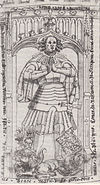 |
1368 | 1371-1429 | 2 July 1429 | County of Weilburg | Anna of Hohenlohe-Weikersheim 1385 one child Elisabeth of Lorraine-Vaudémont 1412 four children | ||
| Henry II | 29 September 1374 | 1378-1412 | 12 October 1412 | County of Beilstein | Catherine of Randerode 1383 four children |
Sons of Henry I, ruled jointly. | ||
| Rainhard | 1374 | 1378-1414/18 | between 30 December 1414 and 17 April 1418 | County of Beilstein | Unmarried | |||
| Anna | 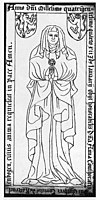
|
c.1330 | 1390-1404 | 21 January 1404 | County of Sonnenberg | Rupert, Count of Nassau-Sonnenberg 1362 no children |
Heir of her husband and her brother. In 1403, renounced the claims over Hadamar and, after her own death, Sonnenberg went to Weilburg line. | |
| 1394-1403 | County of Hadamar | |||||||
| Nassau-Hadamar was annexed to Nassau-Dillenburg | ||||||||
| Nassau-Sonnenberg was annexed to Nassau-Weilburg | ||||||||
| Adolph II | 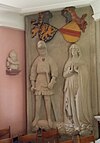 |
1386 | 1393-1426 | 16 July 1426 | County of Idstein | Margaret of Baden-Baden March 1418 six children |
||
| John I | After 1383 | 1414/18-1473 | 1473 | County of Beilstein | Matilda of Isenburg 1415 four children Johanna von Gemen 1477 one child |
Sons of Henry II, ruled jointly. | ||
| Henry III | 1418 | 1414/18-1477 | 12 September 1477 | County of Beilstein | Unmarried | |||
| Adolph I | 1362 | 1388-1420 | 12 June 1420 | County of Dietz | Judith of Dietz 1376 one child |
Sons of John I, ruled jointly, as Tetrarchs. Counts Adolph and Engelbert inherited via his wives half of Diez and Breda, respectively, which became, after their deaths, part of Nassau patrimony. | ||
| 1416-1420 | County of Dillenburg | |||||||
| John II the Elder | 1365 | 1416-1443 | May 1443 | County of Dillenburg | Unmarried | |||
| Engelbert I | 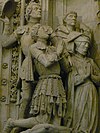
|
1370 | 1403-1442 | 3 May 1442 | Barony of Breda | Johanna van Polanen 1 August 1403 Breda six children | ||
| 1416-1442 | County of Dillenburg | |||||||
| John III the Younger | 1362 | 1416-1429/30 | 1429/30 | County of Dillenburg | Unmarried | |||
| Judith | c.1380? | 1420-1424 | 2 August 1424 | County of Dietz | Godfried VII, Count of Eppstein-Münzenberg 1401 five children |
Inherited half of Dietz (the other part was inherited by her uncles) and after her death passed to the Eppstein family. Dillenburg eventually recovered parts of her share of Dietz in 1530. | ||
| Dietz annexed to County of Eppstein; Recovered to Nassau-Dillenburg in 1530 | ||||||||
| Regency of Margaret of Baden-Baden (1426-1433) | ||||||||
| John II | 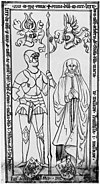 |
1419 | 1426-1480 | 9 May 1480 | County of Idstein | Maria of Nassau-Breda 17 June 1437 Breda six children | ||
| Regency of Elisabeth of Lorraine-Vaudémont (1429–1438) | Sons of Philip I. Philip II was the eldest and received Nassau-Weilburg. Between 1464 and 1490, he also served as regent for count John Louis of Nassau-Saarbrücken, together with Duke Eberhard I of Württemberg, following the death of the count's mother and previous regent. Philip II's younger brother, John, received Saarbrücken in the partitions. | |||||||
| Philip II | 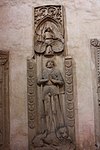 |
12 March 1418 | 1429-1492 | 19 March 1492 | County of Weilburg | Margaret of Loon-Heinsberg 25 September 1440 two children | ||
| Regency of Elisabeth of Lorraine-Vaudémont (1429–1438) | ||||||||
| John II |  |
4 April 1423 | 1429-1472 | 15 July 1472 | County of Saarbrücken | Johanna of Loon-Heinsberg 30 November 1456 two children Elisabeth of Württemberg-Urach 30 October 1470 one child | ||
| John IV | 
|
1 August 1410 | 1442-1475 | 3 February 1475 | Barony of Breda | Mary of Looz-Heinsberg 7 February 1440 six children |
Sons of Engelbert I, ruled jointly in Breda and Dillenburg until 1447. In this year they divided their lands: John kept Breda and Henry, Dillenburg. After the latter's death, the former reunited their possessions. Their sister Maria inherited some unknown possessions in the Netherlands (possibly in Breda), which she contested with her brother John,[2] and possibly passed to Nassau-Idstein. | |
| 1442-1447 1451-1475 |
County of Dillenburg | |||||||
| Henry II | 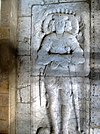
|
7 July 1414 | 1443-1447 | 8 June 1451 | Barony of Breda | Genoveva of Virneburg 1435 one child Irmgard of Schleiden-Junkerath after 1437 no children | ||
| 1443-1451 | County of Dillenburg | |||||||
| Maria |  |
2 February 1418 | 1443-1472 | 11 October 1472 | Barony of Breda | John II 17 June 1437 Breda six children | ||
| Regencies of Elisabeth of Württemberg-Urach and Eberhard I, Duke of Württemberg (1472-1474), and Philip II, Count of Nassau-Weilburg (1474-1490) | ||||||||
| John Louis |  |
19 October 1472 | 1472-1545 | 4 June 1545 | County of Saarbrücken | Elisabeth of Palatinate-Zweibrücken 29 January 1492 Saarbrücken six children Catharina van Meurs-Saarwerden 14 February 1507 nine children | ||
| Engelbert II the Valorious | 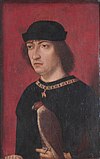 |
17 May 1451 | 1475-1504 | 31 May 1504 | Barony of Breda | Cymburgis of Baden-Baden 19 December 1468 Koblenz no children |
Children of John IV, divided the land: Engelbert inherited Breda in the Netherlands (with the towns of Lek, Diest, Roosendaal en Nispen, Wouw, and Vianden) and John inherited Dillenburg (with the towns of Dillenburg, Siegen, Hadamar, Herborn, Vianden, Dietz). Engelbert was also Governor of the Habsburg Netherlands, and left no descendants, being succeeded by John's eldest son Henry III. | |
| John V | 9 November 1455 | 1475-1516 | 30 July 1516 | County of Dillenburg | Elisabeth of Hesse-Marburg 11 February 1481 six children | |||
| Henry IV | 1449 | 1477-1499 | 26 May 1499 | County of Beilstein | Eva of Sayn 1464 ten children |
|||
| Philip | 1450 | 1480-1509 | 16 June 1509 | County of Idstein | Margaret of Zweibrücken-Veldenz 1470 no children |
Children of John II, divided the land: Philip kept Idstein and Adolph inherited Wiesbaden. Once more, the holder of Wiesbaden reunited the county. | ||
| Adolph III | 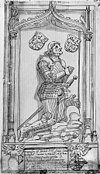 |
10 November 1443 | 1480-1511 | 6 July 1511 | County of Idstein (At Wiesbaden 1480-1509) |
Margaret of Hanau-Lichtenberg 20 June 1484 four children | ||
| Louis I | 1473 | 1492-1523 | 28 May 1523 | County of Weilburg | Maria Margaretha of Nassau-Idstein 19 April 1501 six children |
|||
| John II | 1475 | 1499-1513 | 18 August 1513 | County of Beilstein | Maria of Solms 1492 four children Anna of Lippe 1510 no children |
|||
| Henry III | 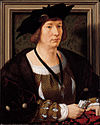 |
12 January 1483 | 1504-1538 | 14 September 1538 | Barony of Breda | Louise-Françoise of Savoy 3 August 1503 no children Claudia of Chalon May 1515 one child Mencía de Mendoza 26 June 1524 one child |
Son of John V, inherited Nassau-Breda from his uncle Engelbrecht II. | |
| Philip I the Elder | 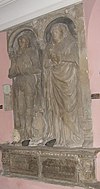 |
26 April 1492 | 1511-1554 | 6 June 1558 | County of Idstein | Adriana of Glymes 24 August 1514 Bergen op Zoom six children |
Abdicated for his children, who divided the land once more. | |
| John III | 17 November 1495 | 1513-1561 | 13 December 1561 | County of Beilstein | Anna of Nassau-Weilburg 1523 no children |
Sons of John II, ruled jointly. They had no descendants and after their death the county was annexed to Nassau-Dillenburg. | ||
| Henry V | After 1495 | 1513-1525 | 25 February 1525 | County of Beilstein | Unmarried | |||
| Bernard | 1479/85 | 1513-1556 | 10 May 1556 | County of Beilstein | Unmarried | Brother of John II, ruled jointly with his nephews. | ||
| Nassau-Beilstein merged again in Nassau-Dillenburg | ||||||||
| William I the Rich |  |
10 April 1487 | 1516-1559 | 6 October 1559 | County of Dillenburg | Walburga of Egmont 29 October 1519 Koblenz two children Juliana of Stolberg 29 September 1531 Königstein twelve children |
Son of John V, inherited Nassau-Dillenburg. During his reign (1530), parts of Judith's half of Dietz are recovered. | |
| Philip III | 20 September 1504 | 1523-1559 | 4 October 1559 | County of Weilburg | Elisabeth of Sayn-Hachenburg 2 March 1523 four children Anna of Mansfeld-Hinterort 23 September 1536 one child Amalia of Isenburg-Büdingen 17 August 1541 Büdingen three children |
|||
| René | 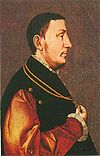 |
5 February 1519 | 1538-1544 | 15 July 1544 | Principality of Orange (1530-44) Barony of Breda (1538-44) |
Anna of Lorraine 22 August 1540 Bar-le-Duc one child |
Son of Henry III, inherited Nassau-Breda from his father and the Principality of Orange from his mother. Left no descendants, and gave his patrimony to his cousin. | |
| William I the Silent |  |
24 April 1533 | 1544-1584 | 10 July 1584 | Principality of Orange Barony of Breda |
Anna van Egmont 8 July 1551 Buren three children Anna of Saxony 24 August 1561 Leipzig (annulled 14 December 1571) five children Charlotte of Bourbon 12 June 1575 Brielle six children Louise de Coligny 12 April 1583 Antwerp one child |
Eldest son of William the Rich, inherited his cousin's lands, and left his father's inheritance to his younger brothers. Also Count of Katzenelnbogen, Vianden, Dietz, Buren and Leerdam and Lord of IJsselstein, Baron of Breda, etc. Stadholder of Holland, Zealand and Utrect, etc. Murdered in 1584. | |
| Philip II | 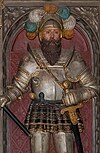 |
25 July 1509 | 1545-1554 | 19 June 1554 | County of Saarbrücken | Apollonia of Leiningen-Hartenburg 17 July 1535 no children |
Left no descendants. He was succeeded by his brother. | |
| John III |  |
5 April 1511 | 1554-1574 | 23 November 1574 | County of Saarbrücken | Unmarried | Left no descendants. The land was absorbed by Nassau-Weilburg. | |
| Nassau-Saarbrücken merged again in Nassau-Weilburg | ||||||||
| Adolph IV |  |
1518 | 1554-1556 | 5 January 1556 | County of Idstein | Unmarried | Children of Philip I, divided the land. Adolph kept Idstein and Philip inherited Wiesbaden. After Adolph IV's death, Philip II reunited Idstein, but divided it again with another brother, Balthasar. | |
| Philip II the Younger |  |
1516 | 1554-1566 | 3 January 1566 | County of Idstein (At Wiesbaden 1554-56 and 1564-66) |
Unmarried | ||
| Albert | 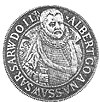 |
26 December 1537 | 1559-1593 | 11 November 1593 | County of Weilburg (at Ottweiler) |
Anna of Nassau-Dillenburg 23 September 1536 fourteen children |
Sons of Philip I, ruled jointly. In 1574 annexed Nassau-Saarbrücken | |
| Philip IV |  |
14 October 1542 | 1559-1602 | 12 March 1602 | County of Weilburg | Erica of Manderscheid-Blankenheim 9 April 1563 one child Elisabeth of Nassau-Dillenburg 3 October 1583 no children | ||
| John VI the Elder |  |
22 November 1536 | 1559-1606 | 8 October 1606 | County of Dillenburg | Elisabeth of Leuchtenberg 6 June 1559 Dillenburg thirteen children Kunigunde Jakobäa of Simmern 13 September 1580 Dillenburg four children Johannetta of Sayn-Wittgenstein 14 June 1586 Berleburg seven children |
Younger brother of William the Silent, inherited his father's domains, which were divided after his own death. | |
| Balthasar | 1520 | 1564-1568 | 11 January 1568 | County of Idstein (At Idstein 1564-66) |
Margaret of Isenburg-Birstein 9 June/6 September 1564 one child |
Brother of Adolph IV and Philip II. Definitely reunited Idstein. | ||
| Regency of Margaret of Isenburg-Birstein (1568-1587) | ||||||||
| John Louis I | 10 April 1567 | c.1587-1596 | 10 June 1596 | County of Idstein | Maria of Nassau-Dillenburg 2 December 1588 Idstein six children | |||
| Philip William | 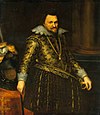 |
19 December 1554 | 1584-1618 | 20 February 1618 | Principality of Orange Barony of Breda |
Éléonore de Bourbon 23 November 1606 Fontainebleau no children |
Left no descendants. He was succeeded by his half-brother Maurice. | |
| Anna of Nassau-Dillenburg | 21 September 1541 | 1593-1616 | 12 February 1616 | County of Weilburg (at Wehen) |
Albert, Count of Nassau-Weilburg 23 September 1536 fourteen children |
Widow of Albert of Nassau-Weilburg, inherited the town of Wehen. | ||
| John Casimir | 24 September 1577 | 1593-1602 | 29 March 1602 | County of Weilburg (at Ottweiler and Gleiberg) |
Elisabeth of Hesse-Darmstadt 10 May 1601 Weilburg one child |
Son of Albert, inherited Ottweiler and Gleiberg. After his death his possessions returned to Weilbrug. | ||
| Regency of Maria of Nassau-Dillenburg (1596-1605) | Died as minors. After John Louis' death, his lands were annexed to Nassau-Weilburg. | |||||||
| John Philip | 26 March 1595 | 1596-1599 | 29 August 1599 | County of Idstein | Unmarried | |||
| John Louis II | 21 May 1596 | 1599-1605 | 19 June 1605 | County of Idstein | Unmarried | |||
| Nassau-Idstein merged again in Nassau-Weilburg | ||||||||
| Louis II | 9 August 1565 | 1602-1627 | 8 November 1627 | County of Weilburg | Anna Maria of Hesse-Kassel 8 June 1589 Kassel fourteen children |
In 1605 reunited all Southern Nassau. However he divided it again after his death between his sons. | ||
| William Louis | 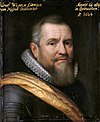 |
13 March 1560 | 1606-1620 | 13 July 1620 | County of Dillenburg | Anna of Orange-Nassau 25 November 1587 Franeker no children |
Children of John VI, divided the land:
| |
| John VII the Middle | 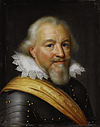 |
7 June 1561 | 1606-1623 | 27 September 1623 | County of Siegen | Magdalene of Waldeck-Wildungen 9 December 1581 Dillenburg twelve children Margaret of Schleswig-Holstein-Sonderburg 27 August 1603 Dillenburg thirteen children | ||
| George |  |
1 September 1562 | 1606-1623 | 9 August 1623 | County of Beilstein (1606-23) County of Dillenburg (1620-23) |
Anna Amalia van Nassau-Saarbrücken 1584 fourteen children Amalia of Sayn-Wittgenstein 1605 one child | ||
| Ernest Casimir |  |
22 December 1573 | 1606-1632 | 2 June 1632 | County of Dietz | Sophia Hedwig of Brunswick-Lüneburg 8 June 1607 Dillenburg two children | ||
| John Louis |  |
6 August 1590 | 1606-1653 | 10 March 1653 | County of Hadamar (1606-50) Principality of Hadamar (1650-53) |
Ursula of Lippe 1617 fourteen children | ||
| Elisabeth of Hesse-Darmstadt | 29 November 1579 | 1616-1655 | 17 July 1655 | County of Weilburg (at Wehen) |
John Casimir, Count of Nassau-Gleiberg 10 May 1601 Weilburg one child |
Widow of John Casimir, inherited from her mother-in-law her seat at Wehen. At her death, Wehen was inherited by Nassau-Idstein. | ||
| Maurice |  |
14 November 1567 | 1618-1625 | 23 April 1625 | Principality of Orange Barony of Breda |
Unmarried | Left no descendants. He was succeeded by his half-brother Frederick Henry. | |
| John VIII the Younger |  |
29 September 1583 | 1623-1638 | 27 July 1638 | County of Siegen (Catholic branch) |
Ernestine Yolande de Ligne 13 August 1618 Brussels thirteen children |
Sons of John VII, divided the land once more, this time in religious matters:
| |
| John Maurice the Brazilian |  |
17 June 1604 | 1632-1679 | 20 December 1679 | County of Siegen (Protestant branch, 1632-64) Principality of Siegen (Protestant branch, 1664-79) |
Unmarried | ||
| William |  |
13 August 1592 | 1624-1642 | 17 July 1642 | County of Siegen (Protestant branch, at Hilchenbach) |
Christiane of Erbach 17 January 1619 Siegen seven children | ||
| Louis Henry |  |
9 May 1594 | 1623-1662 | 12 July 1662 | County of Dillenburg (1623-54) Principality of Dillenburg (1654-62) |
Catherine of Sayn-Wittgenstein 1615 twelve children Elizabeth of Salm-Dhaun 1653 no children Sophie of Nassau-Hadamar 1656 three children |
Sons of George, ruled jointly. | |
| Albert |  |
1 November 1596 | 1623-1626 | 16 June 1626 | County of Dillenburg | Unmarried | ||
| Frederick Henry | 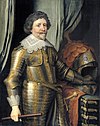 |
29 January 1584 | 1625-1647 | 14 March 1647 | Principality of Orange Barony of Breda |
Amalia of Solms-Braunfels 4 April 1625 The Hague nine children |
||
| William Louis | 18 December 1590 | 1627-1640 | 22 August 1640 | Nassau-Saarbrücken | Anna Amalia of Baden-Durlach 25 November 1615 Durlach twelve children |
Children of Louis II, divided the land:
| ||
| John |  |
24 November 1603 | 1627-1677 | 23 May 1677 | County of Idstein | Sibylla Magdalena of Baden-Durlach 6 June 1629 Strasbourg nine children Anna of Leiningen-Dagsburg-Falkenburg 6 December 1646 Strasbourg seventeen children | ||
| Ernest Casimir | 15 November 1607 | 1627-1655 | 16 April 1655 | County of Weilburg | Anna Maria of Sayn-Wittgenstein-Hachenburg 22 February 1634 Weilburg six children | |||
| Henry Casimir I |  |
21 January 1612 | 1632-1640 | 13 July 1640 | County of Dietz | Unmarried | Left no descendants. He was succeeded by his brother. | |
| Regency of Ernestine Yolande de Ligne d'Amblise (1638-1651) | Had to cede a part of the County to the Protestant branch of the family in 1648. He kept fighting his Protestant neighbours and suppressing the Calvinists in his territory. His reign was marked by bad management and debts. However, in 1652, he was elevated to Imperial Prince. | |||||||
| John Francis Desideratus |  |
28 July 1627 | 1638-1699 | 17 November 1699 | County of Siegen (Catholic branch, 1638-52) Principality of Siegen (Catholic branch, 1652-99) |
Johanna Claudia of Königsegg-Rotenfels-Aulendorf 14 May 1651 Vienna ten children Marie Eleonore Sophie of Baden-Rodemachern 31 May 1665 Rodemachern four children Isabella Clara du Puget de la Serre 9 February 1669 Brussels ten children | ||
| William Frederick |  |
7 August 1613 | 1640-1664 | 31 October 1664 | County of Dietz (1632-54) Principality of Dietz (1654-64) |
Albertine Agnes of Orange-Nassau 2 May 1652 Kleve three children |
||
| Regency of Anna Amalia of Baden-Durlach (1638-1642) | Anna Amalia exerted regency of her son Crato, and then took the County of Saarwerden, while regent in the name of her second son in Saarbrucken. After her death, Saarwerden reunited with Saarbrucken. In 1659, John divided the land with his other brothers, in which he received Ottweiler. Count of Nassau-Saarbrücken and (1659–80) in Ottweiler, Jungenheim, and Wöllstein. Between 1677 and 1680 he also served as regent for Count John Ernest of Nassau-Weilburg. | |||||||
| Crato | 7 April 1621 | 1640-1642 | 25 July 1642 | County of Saarbrücken | Unmarried | |||
| Anna Amalia of Baden-Durlach | 18 December 1590 | 1642-1651 | 22 August 1640 | Nassau-Saarbrücken (at Saarwerden) |
William Louis, Count of Nassau-Saarbrücken 25 November 1615 Durlach twelve children | |||
| Regency of Anna Amalia of Baden-Durlach (1642-1651) | ||||||||
| John Louis | 23 May 1625 | 1642-1659 | 9 February 1690 | County of Saarbrücken | Dorothea Catherine of Palatinate-Birkenfeld-Bischweiler 6 October 1649 Bischweiler eight children | |||
| 1659-1690 | County of Ottweiler | |||||||
| William II |  |
27 May 1626 | 1647-1650 | 6 November 1650 | Principality of Orange Barony of Breda |
Mary of Great Britain 2 May 1641 London one child |
||
| Mary of Great Britain | 4 November 1631 | 1650-1660 | 24 December 1660 | Barony of Breda | William II 2 May 1641 London one child |
Given her inherited seat in Breda, she may have had the entire hereditary barony, which passed then to her son. | ||
| Regencies of Mary of Great Britain (1650-1660) and Amalia of Solms-Braunfels (1650-1672) | Became King of England and Scotland (Great Britain) in 1688, jointly with his wife. Left no descendants. He named his cousin John William Friso of Nassau-Dietz as his heir in The Netherlands and the principality of Orange, passing over the claims of the Hohenzollerns of Brandenburg/Prussia. | |||||||
| William III |  |
4 November 1650 | 1650-1702 | 8 March 1702 | Principality of Orange Barony of Breda (from 1660) |
Mary II, Queen of Great Britain 4 November 1677 London no children | ||
| Principality of Orange (and Breda) inherited by Nassau-Dietz | ||||||||
|
In 1702, the Nassau-Dietz branch followed the House of Orange that had become extinct with William III of England (d. 1702). The counts of Nassau-Dietz not only descended from William the Silent's brother, but in female line also from himself, as William Frederick, Prince of Nassau-Dietz, had married Countess Albertine Agnes of Nassau, the fifth daughter of Frederick Henry, Prince of Orange in 1652. | ||||||||
| Maurice Henry |  |
23 April 1626 | 1653-1679 | 24 January 1679 | Principality of Hadamar | Ernestine Charlotte of Nassau-Siegen 30 January 1650 Siegen six children Maria Leopoldine of Nassau-Siegen 12 August 1669 Siegen three children Anna Louise of Manderscheid-Blankenheim 24 October 1675 Hachenburg six children |
||
| Frederick | 26 April 1640 | 1655-1675 | 8 September 1675 | County of Weilburg | Christiane Elisabeth von Sayn-Wittgenstein-Homburg 26 May 1663 three children |
|||
| Gustav Adolph |  |
27 March 1632 | 1659-1677 | 9 October 1677 | County of Saarbrücken | Eleonore Klara of Hohenlohe-Neuenstein 14 June 1662 seven children |
Brothers of John Louis of Nassau-Saarbrücken, divided the land: Gustav kept Saarbrücken, and Waleran inherited Usingen. | |
| Waleran |  |
25 February 1635 | 1659-1702 | 17 October 1702 | County of Usingen (1659-88) Principality of Usingen (1688-1702) |
Catherine Françoise of Croÿ-Roeulx 16 June 1678 Mechelen three children Magdalena Elizabeth of Löwenstein-Wertheim-Rochefort 1686 no children | ||
| Henry | 28 August 1641 | 1662-1701 | 18 April 1701 | Principality of Dillenburg | Dorothea Elizabeth of Brzeg 13 October 1663 sixteen children |
Grandson of Louis Henry, as son of George Louis, Heir of Nassau-Dillenburg. | ||
| Regency of Albertine Agnes of Orange-Nassau (1664-1677) | ||||||||
| Henry Casimir II |  |
18 January 1657 | 1664-1696 | 25 March 1696 | Principality of Dietz | Henriëtte Amalia of Anhalt-Dessau 26 November 1683 Dessau nine children | ||
| Regencies of John, Count of Nassau-Idstein (1675-1677) and John Louis, Count of Nassau-Ottweiler (1677-1680) | ||||||||
| John Ernest |  |
13 June 1664 | 1675-1719 | 27 February 1719 | Couny of Weilburg | Maria Polyxena of Leiningen-Dagsburg-Hartenburg 3 April 1683 nine children | ||
| Louis Crato |  |
28 March 1663 | 1677-1713 | 14 February 1713 | County of Saarbrücken | Philippine Henriette of Hohenlohe-Langenburg 25 April 1699 eight children |
Left no male descendants. He was succeeded by his brother Charles Louis. | |
| George August |  |
26 February 1665 | 1677-1721 | 26 October 1721 | County of Idstein (1677-88) Principality of Idstein (1688-1721) |
Henriette Dorothea of Oettingen 22 September 1688 Kirchheim unter Teck twelve children |
||
| Nassau-Idstein was annexed by Nassau-Saarbrücken | ||||||||
| Regency of Francis Bernard of Nassau-Hadamar (1679-1694) | Left no surviving descendants, and his lands were divided by Nassau-Siegen, Nassau-Dillenburg and Nassau-Diez in 1717. | |||||||
| Francis Alexander |  |
27 January 1674 | 1679-1711 | 27 May 1711 | Principality of Hadamar | Elizabeth Catherine Felicitas of Hesse-Rotenburg 18 October 1695 Lovosice (annulled 1705) fourteen children | ||
| Nassau-Hadamar divided between Nassau-Dietz, Nassau-Dillenburg and Nassau-Siegen | ||||||||
| William Maurice |  |
18 January 1649 | 1679-1691 | 23 January 1691 | Principality of Siegen (Protestant branch) |
Ernestine Charlotte of Nassau-Schaumburg 6 February 1678 Schaumburg two children |
||
| Regency of Ernestine Charlotte of Nassau-Schaumburg (1691-1701) | ||||||||
| Frederick William Adolf |  |
20 February 1680 | 1691-1722 | 13 February 1722 | Principality of Siegen (Protestant branch) |
Elisabeth of Hesse-Homburg 7 January 1702 five children Amalie Louise of Courland 13 April 1708 eight children | ||
| Regency of Henriëtte Amalia of Anhalt-Dessau (1696-1708) | Became Stadholder in Friesland and Groningen, and in 1702 became the heir of William III and thus the founder of the younger House of Orange-Nassau and of the Dutch Royal Family. However, he had to split the Dutch properties with the King of Prussia who also descended from William I. | |||||||
| John William Friso |  |
14 August 1687 | 1696-1711 | 14 July 1711 | Principality of Dietz (as Nassau-Dietz, 1696-1702; as Orange-Nassau, 1702-11) Principality of Orange Barony of Breda (as Orange-Nassau, 1702-11) |
Marie Louise of Hesse-Kassel 26 April 1709 Kassel two children | ||
| William Hyacinth |  |
3 April 1667 | 1699-1743 | 18 April 1743 | Principality of Siegen (Catholic branch) |
Maria Francisca of Fürstenberg-Heiligenberg 9 April 1687 Liège three children Maria Anna of Hohenlohe-Waldenburg-Schillingsfürst 22 May 1698 Frankfurt one child Sophia of Starhemberg 28 July 1740 Vienna no children |
Son of John Francis Desideratus. Mismanaged the government of the principality and was removed from executive power 1707-1740. He inherited 1/6 of Nassau-Hadamar in 1711 and 1/2 of Nassau-Dillenburg in 1739. He ceded his part of Nassau-Dillenburg to William IV of Orange-Nassau in 1742 and received the latters part of Nassau-Hadamar in return. He was succeeded by William IV of Orange-Nassau. | |
| William II | 28 August 1670 | 1701-1724 | 21 September 1724 | Principality of Dillenburg | Johanna Dorothea of Schleswig-Holstein-Sonderburg-Plön-Norburg 13 January 1699 Harzgerode two children |
Left no surviving descendants. He was succeeded by his brother. | ||
| William Henry |  |
2 May 1684 | 1702-1718 | 14 February 1718 | Principality of Usingen | Charlotte Amalia of Nassau-Dillenburg 15 April 1706 Dillenburg nine children |
||
| Regency of Marie Louise of Hesse-Kassel (1711-1729) | Inherited a number of Nassau territories besides his paternal Nassau-Dietz, namely 1/3 of Nassau-Hadamar in 1711, protestant Nassau-Siegen in 1734, and 1/2 of Nassau-Dillenburg in 1739. In 1732, Frederick William I of Prussia left him his Dutch properties, including Huis ten Bosch palace and Het Loo Palace. Ceded his part of Nassau-Hadamar to William Hyacinth of Nassau-Siegen in 1742 and received the latters part of Nassau-Dillenburg. Succeeded William Hyacinth in 1743, and reunited all of the German possessions of the Ottonian Line of his family in his hand, renaming his county into Nassau-Dillenburg, and styling himself Prince of Orange and Nassau. William IV became stadtholder of the Netherlands in 1747. | |||||||
| William IV |  |
1 September 1711 | 1711-1751 | 22 October 1751 | Principality of Orange (1711-13) Barony of Breda (1711-51) Principality of Dietz (1711-51) (as Orange-Nassau) |
Anne of Great Britain 25 March 1734 London three children | ||
| In 1713, Orange was annexed to France. From 1713, the use of the title was merely nominal | ||||||||
| Charles Louis | 6 January 1665 | 1713-1723 | 6 December 1723 | County of Saarbrücken | Christiane Charlotte of Nassau-Ottweiler 22 April 1713 Saarbrücken two children |
Left no descendants. The land went to his cousin from Nassau-Ottweiler. | ||
| Charles August |  |
17 September 1685 | 1719-1753 | 9 November 1753 | County of Weilburg | Auguste Friederike of Nassau-Idstein 17 August 1723 Wiesbaden seven children |
||
| Regency of Amalie Louise of Courland (1722-1726) | Left no surviving male descendants. After his death (which determined the extinction of the line) in 1734, Emperor Charles VI transferred the protestant county of Nassau-Siegen to the House of Orange-Nassau as the inheritors. | |||||||
| Frederick William II | 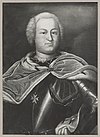 |
11 November 1706 | 1722-1734 | 11 November 1734 | Principality of Siegen (Protestant branch) |
Sophie Polyxena Concordia of Sayn-Wittgenstein-Hohenstein 23 September 1728 five children | ||
| Nassau-Siegen was annexed by Nassau-Dillenburg and Nassau-Dietz | ||||||||
| Frederick Louis | 
|
13 November 1651 | 1690-1723 | 25 May 1728 | County of Ottweiler | Christiane van Ahlefeldt 28 July 1680 eight children Louise Sophie of Hanau-Lichtenberg 27 September 1697 no children |
Count of Nassau-Ottweiler (1680–1728), and in Rixingen (1703–28), and Idstein (1721–1728), and in Wiesbaden, etc. (1723–28). In 1723 inherited Saarbrücken, reuniting Ottweiler with the newly-inherited land. After his death, Saarbrücken briefly mergen with Nassau-Usingen. | |
| 1723-1728 | County of Saarbrücken | |||||||
| Nassau-Ottweiler merged again in Nassau-Saarbrücken | ||||||||
| Christian | 12 August 1688 | 1724-1739 | 28 August 1739 | Principality of Dillenburg | Isabella Charlotte of Nassau-Dietz 1725 no children |
Left no surviving descendants and his lands were inherited by Nassau-Dietz and catholic Nassau-Siegen. | ||
| Nassau-Dillenburg was inherited by Orange-Nassau (Nassau-Dietz) and catholic Nassau-Siegen | ||||||||
| Regency of Charlotte Amalia of Nassau-Dillenburg (1718-1734) | Sons of William Henry. Charles was the only heir, but in 1741 he divided the inheritance, and gave Saarbrücken to his brother (raised as a principality), and retained Usingen. | |||||||
| Charles |  |
31 December 1712 | 1718-1741 | 21 June 1775 | Principality of Usingen | Christine Wilhelmine of Saxe-Eisenach 26 December 1734 four children Magdalene Gross of Wiesbaden after 1740 (morganatic) four children | ||
| William Henry II |  |
6 March 1718 | 1741-1768 | 24 July 1768 | Principality of Saarbrücken | Sophie of Erbach-Erbach 28 February 1742 Erbach five children | ||
| Regencies of Anne of Great Britain (1751-1759, Marie Louise of Hesse-Kassel (1759-1765), Louis Ernest, Duke of Brunswick-Bevern (1759-1766) and Carolina of Orange-Nassau (1765-1766) | ||||||||
| William V |  |
8 March 1748 | 1751-1806 | 9 April 1806 | Principality of Dietz Barony of Breda (as Orange-Nassau) |
Wilhelmina of Prussia I 4 October 1767 Berlin five children | ||
| Charles Christian | 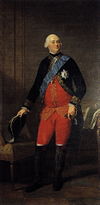 |
16 January 1735 | 1753-1788 | 28 November 1788 | County of Weilburg | Carolina of Orange-Nassau 5 March 1760 The Hague fifteen children Barbara Giessen 2 October 1788 (morganatic) no children |
||
| Louis |  |
3 January 1745 | 1768-1794 | 2 March 1794 | Principality of Saarbrücken | Wilhelmine of Schwarzburg-Rudolstadt 30 October 1766 Schwarzburg one child Katharina Kest 30 October 1766 (morganatic, legitimized 1787) seven children |
||
| Charles William |  |
9 November 1735 | 1775-1803 | 17 May 1803 | Principality of Usingen | Caroline Felizitas of Leiningen-Dagsburg 16 April 1760 one child |
Left no descendants. He was succeeded by his brother. | |
| In 1783, the heads of various branches of the House of Nassau sealed the Nassau Family Pact (Erbverein) to regulate future succession in their states, and to establish a dynastic hierarchy whereby the Prince of Orange-Nassau-Dietz was recognised as President of the House of Nassau.[3] | ||||||||
| Henry Louis | 9 March 1768 | 1794-1797 | 27 April 1797 | Principality of Saarbrücken | Marie Françoise Maximilienne of Saint Mauris-Montbarrey 6 October 1785 no children |
After his death Nassau-Saarbrücken was occupied by France. | ||
| Nassau-Saarbrücken was annexed by France | ||||||||
| Frederick Augustus | 
|
23 April 1738 | 1803-1806 | 24 March 1816 | Principality of Usingen | Louise of Waldeck 9 June 1775 seven children |
From 1806 ruled jointly. Frederick William retained the title of Prince of Nassau, and Frederick Augustus maintained his title of Duke. | |
| 1806-1816 | Duchy of Nassau | |||||||
| Nassau-Usingen united with Nassau-Weilburg to form the Duchy of Nassau | ||||||||
| Frederick William | 
|
25 October 1768 | 1788-1806 | 9 January 1816 | County of Weilburg | Louise Isabelle of Kirchberg 31 July 1788 Hachenburg four children | ||
| 1806-1816 | Duchy of Nassau | |||||||
| Nassau-Weilburg united with Nassau-Usingen to form the Duchy of Nassau | ||||||||
| William VI |  |
24 August 1772 | 1806 1813-1815 |
12 December 1843 | Principality of Dietz Barony of Breda (as Orange-Nassau) |
Wilhelmina of Prussia II 1 October 1791 Berlin six children Henrietta d'Oultremont 17 February 1841 (morganatic) no children |
Ascended 9 April 1806, and on 27 October his lands were annexed to the Duchy of Nassau. He revived the Principality of Orange-Nassau, but in 1815 was proclaimed King of the Netherlands. His Nassau lands returned to the Duchy of Nassau. See List of monarchs of the Netherlands for extended information on the descendants of William. | |
| In 1806 (an then again in 1815), Dietz and Breda were annexed to the Duchy of Nassau | ||||||||
| William | 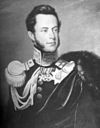 |
14 June 1792 | 1816-1839 | 20/30 August 1839 | Duchy of Nassau | Louise of Saxe-Hildburghausen 24 June 1814 Weilburg eight children Pauline of Württemberg 23 April 1829 Stuttgart four children |
||
| Adolph | 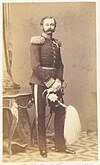 |
24 July 1817 | 1839-1866 | 17 November 1905 | Duchy of Nassau | Elizabeth Mikhailovna of Russia 31 January 1844 St. Petersburg no children Adelheid-Marie of Anhalt-Dessau 23 April 1851 Dessau five children |
In 1866 lost his Nassau lands, but he was granted in 1890 the Grand Duchy of Luxembourg after the death of his cousin without male descendants. See List of monarchs of Luxembourg for extended information on the descendants of Adolph. | |
| In 1866, Nassau was annexed to the Kingdom of Prussia | ||||||||
Nassau's successor states
Kings and Queens of the Netherlands (from the House of Orange-Nassau-Dietz)
- 1815–1840: William I, also Duke and Grand Duke of Luxemburg and Duke of Limburg
- 1840–1849: William II, also Grand Duke of Luxemburg and Duke of Limburg
- 1849–1890: William III, also Grand Duke of Luxemburg and Duke of Limburg
- 1890–1948: Wilhelmina
Following defunct German laws that no longer have relevance due to the end of German nobility, the House of Orange-Nassau(-Dietz) has been extinct since the death of Wilhelmina (1962). Dutch laws and the Dutch nation do not consider it extinct.
- 1948–1980: Juliana
- 1980–2013: Beatrix
- 2013-present: Willem-Alexander
Grand Dukes of Luxembourg (from the House of Nassau-Weilburg)
- 1890–1905: Adolphe
- 1905–1912: William IV
- 1912–1919: Marie-Adélaïde, succession through a female onwards
- 1919–1964: Charlotte
- 1964–2000: Jean
- 2000–present: Henri
See also
References
- ^ a b Abramson, Scott F. (2017-01-01). "The Economic Origins of the Territorial State". International Organization. 71 (1): 97–130. doi:10.1017/S0020818316000308. ISSN 0020-8183.
- ^ (in German) RI XIII H. 5 n. 149 in: Regesta Imperii Online.
- ^ Hay, Mark Edward (1 June 2016). "The House of Nassau between France and Independence, 1795–1814: Lesser Powers, Strategies of Conflict Resolution, Dynastic Networks". The International History Review. 38 (3): 482–504. doi:10.1080/07075332.2015.1046387.
- Articles with German-language sources (de)
- Articles with short description
- Short description with empty Wikidata description
- Articles containing German-language text
- Rhineland-Palatinate articles missing geocoordinate data
- All articles needing coordinates
- Articles missing coordinates without coordinates on Wikidata
- States of the Confederation of the Rhine
- States of the German Confederation
- Nassau (state)
- Former states and territories of Rhineland-Palatinate
- Counties of the Holy Roman Empire




